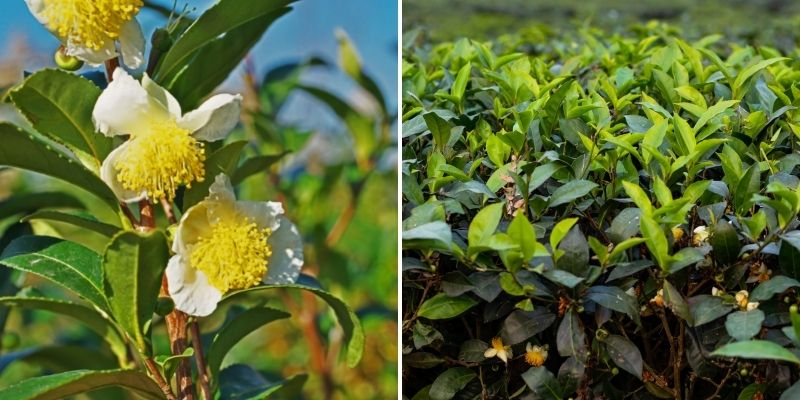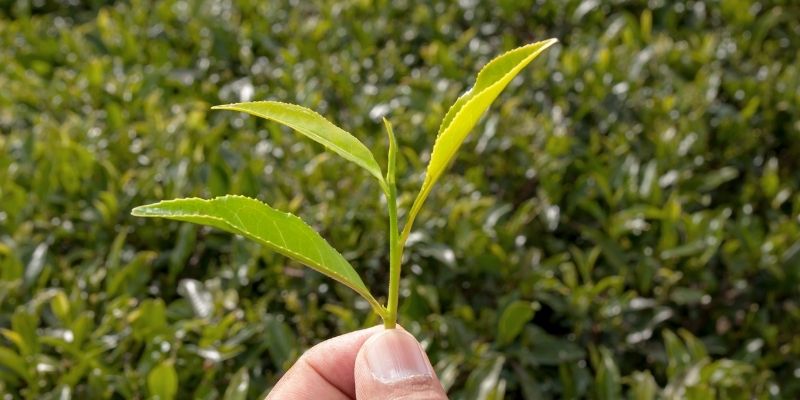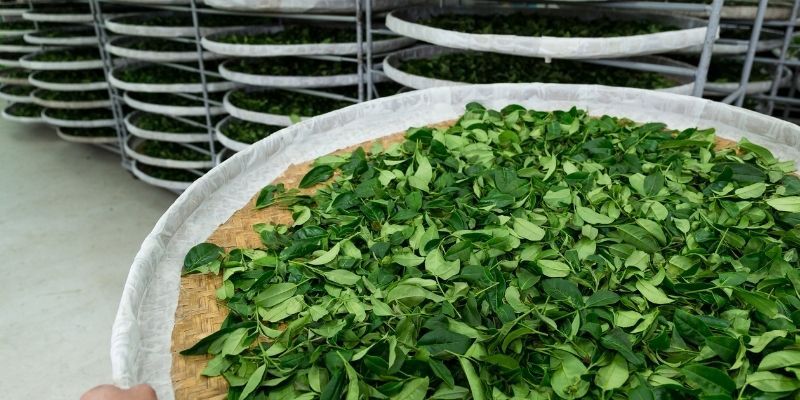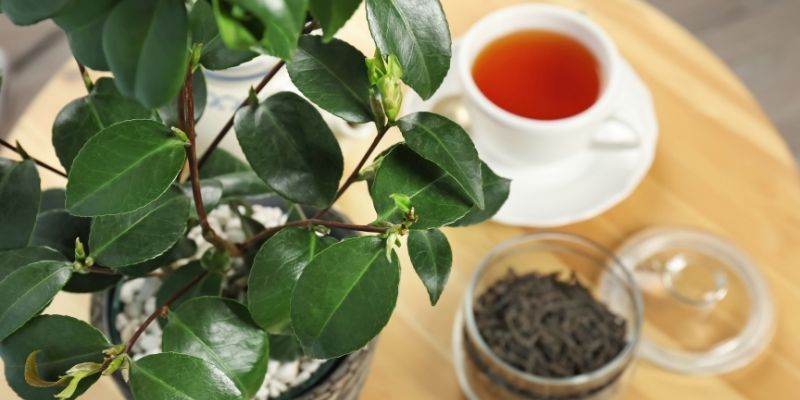Tea is one of the most consumed beverages in the world. Whether green, white, black, oolong or pu-erh, it is produced by drying, then sometimes oxidising or fermenting leaves of a single plant: Camellia sinensis or tea bush. This bush native to southern China has dark green, evergreen, aromatic foliage.
Despite subtropical origins, this perennial of heather soil can acclimatise here, in ground or in a pot. It is therefore possible to grow tea easily at home. Quantities will obviously be modest, but that will not prevent you from enjoying a few cups straight from tea bush in your garden!
Here is our tutorial to make your own tea at home.

Tea bush flowers and leaves
Harvest tea leaves
Harvest takes place in spring and early summer, ideally around May and June. Picking is done on a Camellia sinensis plant aged 2 or 3 years.
Carry out harvesting in early morning on a dry day, when leaves are richest in aromatic compounds, before arrival of hot midday sun. Avoid harvesting the day after rain to make drying easier.
Simply pick young leaves and buds by hand, detaching them gently so as not to damage them or the stems. You can also use scissors disinfected beforehand.
In tea tradition, 'imperial' picking consists of taking one bud plus the preceding leaf; 'fine' picking involves harvesting one bud plus the two preceding leaves. These are the most aromatic parts of the plant. For personal use, we recommend following this method and taking no more than 2 or 3 leaves per stem, so the bush can continue to develop and to enjoy best flavours of the tea bush.
Expect between 4 and 5 kg of fresh leaves to produce 1 kg of dried tea. Unless you start large-scale cultivation of tea bushes, this will obviously not meet needs of a daily tea drinker. But you will have satisfaction of enjoying a truly local, organic beverage if you use no chemical treatments, and homemade. As a bonus, the bush has attractive ornamental qualities! Yield will increase over years as your Camellia sinensis grows.

'Imperial' or 'fine' picking? Your choice!
Dry tea leaves
Tea colour results from different treatments applied to leaves after harvest. To make tea at home, the method used here will resemble that for producing white tea, which is the least processed.
To simplify, for white tea leaves are left to wither for a few days in open air, before being dried for preservation. Green tea undergoes immediate heating to halt oxidation. Black teas and oolong, by contrast, develop their flavours through oxidation. Finally, pu-erh is a fermented tea, much less consumed here.
First step: natural air-drying
- Immediately after harvesting, spread buds and leaves on a sheet, tray, mat or any ventilated support allowing air to circulate to aid drying
- Place them in a warm, dry place, protected from direct sunlight
- Turn after 24 hours for more homogeneous drying
Once leaves have withered, after about 48 hours, proceed to drying stage for preserving tea leaves.
Second step: oven drying
- Preheat oven to low temperature, around 90°C
- Spread buds and leaves on a tray or a silicone mat
- Leave to dry in the oven for about fifteen minutes
- Open oven door regularly to let excess moisture escape
- Gently mix leaves halfway through drying
Leaves are dry when shrivelled and slightly brittle. Take care not to cook them, as they would then lose ability to infuse.
You can also use a dehydrator to dry tea leaves. Follow manufacturer's temperature and drying time guidelines.
Place leaves in an airtight, opaque container to best preserve all flavours of your homemade tea.

On an industrial scale, Camellia sinensis leaves are dried on large racks.
Prepare and flavour your homemade tea
You can enjoy your tea plain, simply by infusing it in hot water for a few minutes.
Also consider flavouring it, pairing it with various ingredients, whether gathered from your garden or not.
- Herb leaves: mint, lemon balm, oregano, thyme, rosemary, lemongrass…
- Fruits: lemon or orange slices, apple slices,…
- Flowers: chamomile, lavender, hibiscus, rose,…
- Spices: cinnamon, clove, ginger,…
- Other bush leaves: blackcurrant, raspberry,…
Enjoy hot or cold, depending on season and taste!

































Comments